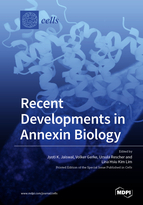Recent Developments in Annexin Biology
A special issue of Cells (ISSN 2073-4409). This special issue belongs to the section "Intracellular and Plasma Membranes".
Deadline for manuscript submissions: closed (31 May 2020) | Viewed by 64511
Special Issue Editors
Interests: calcium; cell imaging; injury and repair; inflammation; membrane trafficking; mitochondria; muscle biology
Interests: membrane organization and dynamics; exo- and endocytosis; calcium-binding proteins; lipid-protein interactions
Interests: host–pathogen interactions; host intracellular compartments; drug repurposing
Special Issues, Collections and Topics in MDPI journals
Special Issue Information
Dear Colleagues,
To mark Annexins 2019, the 10th anniversary meeting of the biennial conference on Annexins, this Special Issue is aimed at sharing a sample of the recent advances in Annexin Biology that were presented at this meeting. With over 40 years since the discovery of Annexins, these proteins first identified for their calcium and membrane binding abilities continue to be recognized for their roles in a wide variety of biological processes. As the variety of biological processes that Annexins play a role in continues to expand, there is a growing need for understanding the properties and function of Annexins. The findings presented at the Annexins 2019 meeting offered such mechanistic insights into Annexin properties and into the role of these proteins in processes ranging from microbial infection, cell and tissue injury to inflammation and cancer, to name a few. While several other interesting biological aspects of Annexins were also discussed at the meeting, these were by no means exhaustive enough to cover all of the roles of Annexins that have been identified. The compilation of the findings and perspectives presented at this meeting and included in this Special Issue is intended to share these findings with a wider audience and encourage broad participation in understanding these abundant and omnipresent proteins that are still not fully understood.
Prof. Jyoti K. Jaiswal
Dr. Volker Gerke
Dr. Ursula Rescher
Dr. Lina Hsiu Kim Lim
Guest Editors
Manuscript Submission Information
Manuscripts should be submitted online at www.mdpi.com by registering and logging in to this website. Once you are registered, click here to go to the submission form. Manuscripts can be submitted until the deadline. All submissions that pass pre-check are peer-reviewed. Accepted papers will be published continuously in the journal (as soon as accepted) and will be listed together on the special issue website. Research articles, review articles as well as short communications are invited. For planned papers, a title and short abstract (about 100 words) can be sent to the Editorial Office for announcement on this website.
Submitted manuscripts should not have been published previously, nor be under consideration for publication elsewhere (except conference proceedings papers). All manuscripts are thoroughly refereed through a single-blind peer-review process. A guide for authors and other relevant information for submission of manuscripts is available on the Instructions for Authors page. Cells is an international peer-reviewed open access semimonthly journal published by MDPI.
Please visit the Instructions for Authors page before submitting a manuscript. The Article Processing Charge (APC) for publication in this open access journal is 2700 CHF (Swiss Francs). Submitted papers should be well formatted and use good English. Authors may use MDPI's English editing service prior to publication or during author revisions.
Keywords
- Annexin
- Calcium
- Cancer
- Diseases
- Infection
- Inflammation
- Injury
- Innate immunity
- Membrane
- Pathogen








